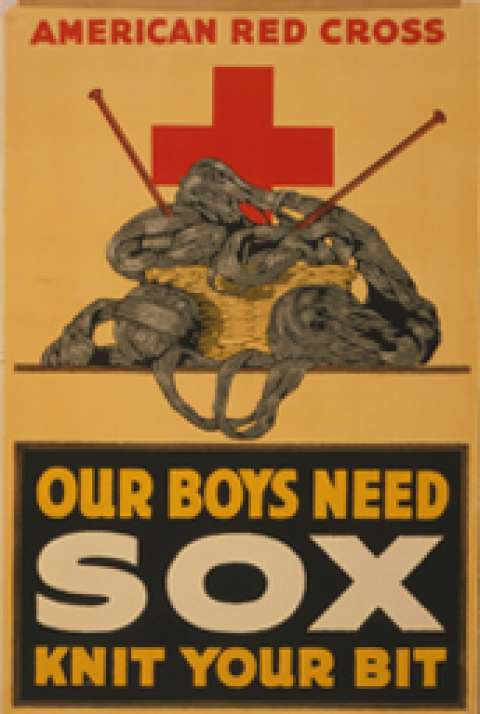Area 8: The U.S. During the First World War (1910s-1920s)
Question: How did the movement of peoples to and within the U.S. affect its society?
Background for teachers and students
“It will probably prove to be the greatest war known in history” –W.E. Chaplin, editor, Laramie Republican, August 1914
While much of the world was fighting a vast war—the Allied powers of Great Britain, France, Italy, Russia and Japan, against the Central Powers of Germany, Austria-Hungary and the Ottoman Empire—America, at first, stayed neutral. War had broken out in Europe in August 1914 after the assassination of the Austrian Archduke Ferdinand. For two and a half years, the United States stayed neutral and President Woodrow Wilson was re-elected in 1916 on the slogan, “He kept us out of war.”
In March 1917, however, the British government turned over to the Americans an intercepted telegram, authored by German Foreign Secretary Arthur Zimmerman, which called on Mexico to join in against the United States with the promise of the return to Mexico the territory it had lost in the war of 1846-1848. After that provocation, American involvement seemed inevitable.
At Wilson’s request, Congress declared war against the Central Powers on April 6, 1917. The greatest challenge for the Wilson administration and the nation became how to raise and train an army and mobilize the support of the people. At the same time, the nation faced large changes related to suffrage, immigration, and alcohol prohibition.
The Wyoming Legislature eagerly supported the declaration of war. Even before Congress had acted on military conscription, Wyoming’s legislature passed a resolution supporting a draft and commending Wilson for severing diplomatic relations with Germany. On March 26, 1917, the Wyoming National Guard was ordered up to federal service. After war was declared, the Wyoming troops trained on the East Coast and were sent to France beginning in December 1917. All told, about 12,000 Wyoming men served—about 6 per cent of the population—a rate well above the national average.
Reports of mass meetings, flag displays, and resolutions in support of President Wilson filled the newspapers. Waves of propaganda washed over the nation and the state. Along with the rest of the nation, most Wyomingites responded to the call to support the war effort.
Social pressure to join in patriotic displays and to buy war bonds intensified. War bonds were a way for people to lend money to the government to fight the war. People with German names came under the suspicion of their neighbors. In an extreme display, war supporters burned all of the German texts at Lander High School at an intersection in the center of town.
At the same time, people ate less and grew more of their own food. Women were central to the efforts on the home front in Wyoming. They worked in jobs that were once dominated by men, pledged to conserve food, devoted time to knitting wool hats and socks for soldiers, prepared bandages for the Red Cross and collected tens of thousands of books for the servicemen serving in France.
Among the most interesting and energetic of people in Wyoming who organized war support was Dr. Grace Raymond Hebard of the University of Wyoming. Hebard was a passionate and devoted defender of the cause. Civil engineer, librarian, athlete, professor and historian, Hebard was a woman of broad talents--a Renaissance woman--who first served the university in the 1890s, both as secretary and member of the Board of Trustees, wherein she handled the University’s finances. She freely admitted that “the Trustees gave me a great deal of power, and I used it.”
At UW she served as university librarian, acted as ad hoc dean of women and taught economics, state and national civics, federal constitutional law, Wyoming law, international law, English constitutional law, sociology, money and banking, political parties, labor problems, railroad organization, children’s literature and storytelling, library science, and western and Wyoming history.
When World War I broke out she also taught citizenship classes for immigrants on the Constitution, patriotism and U.S. history. Her devotion to her state, her unceasing energy and unfailing patriotism qualified her superbly to answer the call to promote wartime programs and rally support for the cause in Wyoming, most particularly among women.
The articles linked below, “Life on the Home Front: Wyoming During World War I” and “Grace Raymond Hebard: Shaping Wyoming’s Past,” offer substantial background on the topic for teachers and for students 8th grade and up. The articles may be demanding for 6th and 7th graders. Caution to teachers: Some students may be sensitive to the topics of adultery and murder mentioned in “Life on the Home Front.”
Read "Life on the Home Front: Wyoming During World War I"
Read "Grace Raymond Hebard: Shaping Wyoming’s Past"



